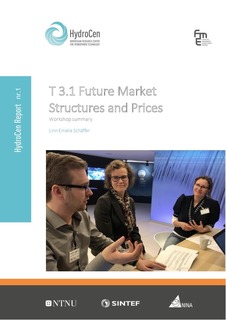| dc.contributor.author | Schäffer, Linn Emelie | |
| dc.date.accessioned | 2019-07-04T13:13:54Z | |
| dc.date.available | 2019-07-04T13:13:54Z | |
| dc.date.issued | 2017 | |
| dc.identifier.isbn | 978-82-93602-00-2 | |
| dc.identifier.uri | http://hdl.handle.net/11250/2603449 | |
| dc.description.abstract | This report summarises the results of the HydroCen workshop in work package 3 Market and services with focus on the drivers of future market structures and prices. The results presented in this report are pro-cessed recapitulations from the group work discussions based on the notes of the group work leaders. The group work discussions revealed uncertainty among the participants regarding several aspects, such as:
• external conditions: e.g. formal market access and requirements to participate in different markets. What impact will the regulatory changes in the EU have on Norwegian stakeholders?
• transmission cables: e.g. how will international cables be regulated? Which products can be traded? Will there be limitations on ramping?
• products: e.g. will energy continue to be the dominating product or will system services become a substan-tial source of income?
• competition: e.g. what role will batteries and demand response play? How will the costs of synthetic system services develop?
• technology development: e.g. how much can efficiency of flexible operation be improved? What new opportunities and competition can power electronics provide?
Even though it is difficult to predict the outcome of many of these factors we can point to some main findings which there seemed to be a general agreement on:
• A surplus of energy is expected from 2020 towards 2030 as a result of investments in new renew-able generation capacity. Higher share of unregulated power production is expected to in-crease price volatility.
• Flexibility is an important strength of hydropower. The need for flexibility services in the Europe-an energy system is increasing. Currently hydropower appears to be the superior technological and cost-efficient solution to the flexibility challenge.
• Demand response will play an important role, but it is uncertain in what scale.
• The risk of investing in hydropower is high (both for new investments and reinvestments). The uncertainty regarding concessions and the revision of these are unfortunately contributing to in-creased risk of investments.
• Hydropower supply services for free which could have been compensated or traded in markets (e.g. flood control and inertia).
• Hydropower production should take advantage of the technology developments within automa-tization, smart systems, improved sensor technology and power electronics.
• The work towards an integrated power market in the EU is important for Norwegian stakeholders. More information is needed. | nb_NO |
| dc.language.iso | eng | nb_NO |
| dc.publisher | Norwegian Re-search Centre for Hydropower Technology | nb_NO |
| dc.relation.ispartofseries | HydroCen Report;1 | |
| dc.title | T 3.1 Future Market Structures and Prices | nb_NO |
| dc.type | Research report | nb_NO |
| dc.description.localcode | © SINTEF 2017. The publication may freely be cited with source acknowledgement. | nb_NO |
